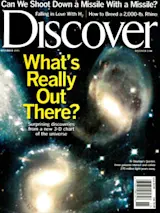Quantum Leaps of Faith Perhaps physicists disagree with David Deutsch's interpretation of quantum theory ["Quantum Shmantum," September] not because it is too strange but because it is too simplistic. I can accept that every particle of my body exists in parallel universes. I cannot accept that these particles are necessarily organized into human beings who have any resemblance to me. In fact, I see no reason to assume that these particles are organized into human beings at all. All of the evidence cited by Deutsch is applicable only to experimental conditions and involves only atomic or subatomic particles. Scientists can teleport atoms, but can they teleport people? Similarly, even if Deutsch could build a supercomputer that utilizes matter from other universes, this still wouldn't prove parallel David Deutsches exist in other universes. All it would prove is that there are parallel universes.
Rob DobsonOverland Park, Kansas
I don't see how ...














